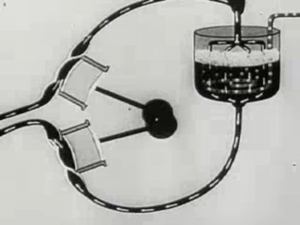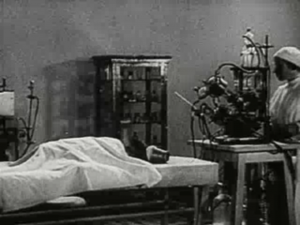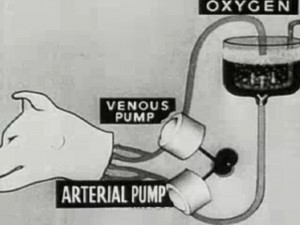Who Really Invented the Heart/Lung Pump And ECPR?
A cult film is one that has special meaning for its viewers. “Casablanca” and “The Rocky Horror Picture Show” are two that immediately come to mind. Cult films attract a special following, the many fans having their own reasons on why they repeatedly enjoy the film. For perfusionists, the closest thing to a cult film is “Experiments in the Revival of Organisms” produced in 1940. The history of the “Revival of Organisms” goes back to 1925 when Dr. Sergei Bryukhonenko (1890-1960), a doctor in the Soviet Union working at the Institute of Experimental Physiology and Therapy in Moscow, first publicly demonstrated his new invention called the “autojector”. The autojector was actually the first practical heart lung machine, although in the West we give the credit to Dr. John Gibbon for conceptualizing and building the first heart lung machine.
The autojector could successfully perform isolated organ perfusion and was used by Soviet surgeons to develop the techniques needed to repair heart valves and other cardiac defects1. By 1938, Dr. Bryukhonenko was able to use the autojector for whole body resuscitation of large dogs that had been killed by controlled hemorrhage. During the First World War, he witnessed many combat injuries of the heart, lungs and major blood vessels and he endeavored to develop a way to provide temporary extracorporeal support so that these injuries could be repaired. This led to his goal of using the autojector to revive solders killed in battle. This is not as wacky as it sounds. The United States Department of Defense has recently sponsored a serious project to do just this2. Dr. Gibbon’s desire to repair the relatively few congenital heart defects in the US population was certainly a noble one. But, in the context of wartime, Dr. Bryukhonenko hoped that the autojector could save some of the twenty million Soviet citizens who were to die violently during the Second World War.
Although Dr. Gibbon and Dr. Bryukhonenko were both working on the development of a heart lung machine there is no evidence that they ever collaborated or benefited from any communication. They each developed very different solutions to the common problems of artificial cardiopulmonary support. Here are some examples of their differences.
Dr. Gibbon first unsuccessfully used a rotating drum oxygenator and then replaced that with a screen oxygenator. Both of these were large, clumsy, inefficient and unreliable. Subsequently, in 1955 Dr. Richard DeWall developed the bubble oxygenator. However, in 1936, Dr. Bryukhonenko’s autojector began successfully using a compact, highly efficient bubble oxygenator. See figure 1. Bubble-type oxygenators would come to dominate cardiopulmonary bypass from the 1960’s through the 1980’s.
Dr. Gibbon used three roller pumps, each with its own motor making the overall contraption very heavy. There was an arterial pump, a venous return pump and a recirculation pump to keep blood moving through the screen oxygenator. If the recirculation pump stopped, the screens drained causing the oxygenator to cease functioning. Dr. Bryukhonenko used two, bi-valved ventricular pumps running off a single motor. These pumps utilized a concept similar to modern day pumps like the Abiomed AB5000™ Ventricular Assist Device (Abiomed, Inc., Danvers, MA) or the Berlin Heart® Ventricular Assist Device (Berlin, Germany). The venous return pump played the dual role of draining the patient and sending blood to the bubbler. Furthermore, the bubble oxygenator was not susceptible to de-priming like the screen oxygenator if the ‘feed’ pump stopped.
Because Dr. Gibbon’s primary objective was to use the heart lung machine to perform open heart surgery, he frequently used sternotomy or thoracotomy to access the aorta and vena cavae for cannulation. Dr. Bryukhonenko’s objective was to revive soldiers killed in battle with as little additional trauma as possible. Therefore, he often used a less invasive cannulation through the carotid artery and internal jugular vein to access the circulation, fore shadowing the typical ECMO neck cannulation by 50 years.
The Gibbon-IBM pump was the size and weight of a spinet piano and rested directly on the floor. The autojector was the size of a parrot cage and light enough to be placed on a table. See figure 2.
By 1941, Germany was at war with the Soviet Union which was now allied with the USA and Britain. Pro-Soviet propaganda was used to foster national friendships even though Soviet achievements in science and technology were often touted as proof that a communist society was superior to western democracy. On Nov. 22, 1943, a film displaying the results of Dr. Bryukhonenko’s experiments was shown to 1000 scientists in New York at the Congress of American-Soviet Friendship. The film was entitled “Experiments in the Revival of Organisms”. Today, the film is in the public domain and can be viewed in its entirety or downloaded from this internet archive web site.
There have been several controversial aspects to the film over the years. For one, in 1943 western critics accused the film of being entirely falsified and that no one could possibly perform the cardiopulmonary feats shown in the film.
Secondly, the concept of isolated organ preservation seemed to be without practical application to people who were unaware that this would be necessary prior to organ transplantation. The organs of brain damaged soldiers could be salvaged, reanimated and transplanted into soldiers with irreversibly damaged hearts or lungs who were being sustained by the autojector.
Seen as another outlandish claim was the process of exsanquinating a dog by controlled hemorrhage (soldiers often bleed to death on the battlefield) until all cardiac and pulmonary function had ceased for 15 minutes and then reviving the animal without lethal physiologic insult. Although not referenced in the film, the Soviets were experts in the use of hypothermia, a legacy that continues today. Perfusionists know that animals and humans can be cooled and arrested for periods much longer than 15 minutes after which they can be rewarmed and revived without harm using a heart lung machine. But, this was not commonly known by Western scientists in 1943 nor by the general population even today.
But, the single most controversial aspect was the sustained animation of a severed dog’s head. See figure 3. This macabre demonstration showed that brain homeostasis and function could be maintained solely by the autojector. The only way to prove this fact was to maintain the animal’s head in a conscious state so that it could react to various stimuli. The visage of a disarticulated head blinking its eyes, twitching its ears and licking its gums with its tongue is unsettling. However, this was important to know if terminally wounded soldiers were to be revived and sustained without brain damage by the autojector while waiting for a new heart or lungs. Unfortunately, that vision never came to pass during the war.
Another cult film, Boris Karloff’s 1931 “Frankenstein”, was still fresh in the public’s mind in 1943. Doctors who experimented with disarticulated body parts in an attempt to bring them back to life were “mad scientists”, akin to Victor Frankenstein, the film’s evil physician who created a living monster from dead body parts using a powerful machine. After seeing “Revival of Organisms”, western critics associated Dr. Bryukhonenko with disarticulated body parts, severed heads, dead bodies and a machine powerful enough to reanimate them all; a true-life, Mary Wollstonecraft Shelley character.
In hindsight, we now know that Dr. Bryukhonenko was simply ahead of his time (no pun intended). The valid medical applications of his experiments with the autojector were lost in the righteous indignation of Western critics. Far from being a mad scientist, he held a respected international reputation among his fellow physicians in areas of blood transfusions and cardiovascular physiology. The feats he demonstrated in the 1940 film have been within Perfusion’s scope of practice since the 1960’s. Dr. Bryukhonenko was also one of the leaders of the Research Institute of Experimental Surgery where Professor A. A. Vishnevsky performed the first Soviet open heart operation in 1957 using much of what Dr. Bryukhonenko had learned from his autojector. As a result of his work in cardiopulmonary physiology, Dr. Bryukhonenko was posthumously awarded the Lenin Prize in 1965, the highest award given to Soviet citizens.
Of all the patients Dr. Gibbon operated on using his heart lung machine there was only one survivor. This disappointment led him to abandon his work on the machine entirely, leaving its further development to others. Perhaps if he had access to an autojector, history may have been very different for him and his patients. Not to discredit Dr. Gibbon’s accomplishments in any way, but Dr. Bryukhonenko, for his ingenuity and foresight, deserves the same kind of accolades from perfusionists shown to Dr. Gibbon.
This film, which documents Dr. Bryukhonenko’s work, should be seen by all perfusionists and future perfusionists for a more complete history of cardiopulmonary bypass, especially at this time when perfusionists are being tasked with reviving cardiac arrest patients outside of the operating room using a modern day autojector; the ECPR pump3-6. Dr. Bryukhonenko’s “Revival of Organisms” has finally and truly come to pass.

Fig. 1 The autojector schematic showing the bubble oxygenator and VAD-type blood pumps. Courtesy Prelinger Archives.

Fig. 2 The autojector sitting on a table top next to a large dog that is being revived after circulatory arrest. Courtesy Prelinger Archives.

Fig. 3 The isolated perfusion of a dog’s head by the autojector was the most controversial aspect of Dr. Bryukhonenko’s experiments. Courtesy Perlinger Archives.

Great piece. Whilst i have not re watched the video on this occasion. i remember watching it several years ago. It is a shame the west were so ready to discredit this innovator. I seem to recall the only unbelievable part of the movie being how vibrant and agile the dogs were in the recovery room!!
Martin- I was a perfusionist for three decades before I learned about Dr. Bryukhonenko and his work. The existence the this extraordinary film makes his story come alive. It is too bad that there is no contemporary film about Dr. Gibbon’s work, at least that I know of.
For those interested in reading more about Dr. Bryukhonenko, I just reviewed an article about his life and work which will appear in the next issue of the ASAIO Journal. Also, Dr. Bryukhonenko is mentioned in Galletti’s “Heart Lung Bypass” textbook published in 1962.